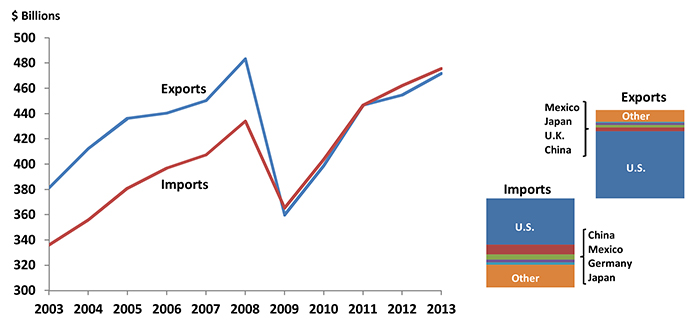How did we do in 2013?
In 2013, the U.S. economy strengthened and Canada saw an increase in pull from emerging markets. While the 2008 global recession may seem like a distant memory, is recovery really in the air for Canada? Foreign Affairs, Trade and Development Canada’s Office of the Chief Economist takes a look at Canada’s 2013 upswing.
Canada’s Merchandise Trade in 2013: The Upswing Continues

With exports growing faster than imports, Canada’s merchandise trade balance was reduced by almost half in 2013 — down from $7.2 billion to $3. billion. In 2013, Canada’s trade deficit was equivalent to less than 1 percent of Canada’s worldwide exports. Growth in exports was supported by energy exports, and also buoyed by significant increases in exports of consumer goods (up 8.0 percent or $3.7 billion). An increasing share of exports headed to Asia. Canada’s exports to Hong Kong doubled in 2013, reaching $4.9 billion; exports to China were up 5.9 percent to $20.5 billion.
Canada’s exports grew 3.7 percent reaching $472 billion in 2013. Exports to our most significant trading partner, the U.S., did well rising 5.5 percent to $358 billion, but support also came from export growth to important emerging markets such as India (up 20.5 percent), Indonesia (up 12.8 percent), and Thailand (up 5.8 percent). Nonetheless, almost 87 percent of Canada’s exports were sent to its top five export destinations.
Resources and resource-based goods continued to make up the majority (59.9 percent) of Canada’s exports. Forestry and energy did particularly well up 10.4 percent to $34 billion and 6.4 percent to $115 billion, respectively.
Also of note, consumer goods exports were up 8.6 percent, growing four times faster than the post-recession annual average growth. In 2013, Canada exported about $50 billion worth of consumer goods. Canada’s exports of non-resource-based goods grew 2.5 percent. Although exports have yet to return to their pre-recession peak, improvements in 2013 moved the country to within three percentage points of its 2008 export high.
Imports grew less than exports, up 3.0 percent in 2013 to $476 billion. Canada’s import sources remained more diversified than exports, but most growth stemmed from common import sources — imports from the U.S. and China were up 6.0 percent to $248 billion and 4.0 percent to $53 billion, respectively. About 25 percent of Canada’s imports came from outside Canada’s top five import sources. And some emerging markets, really pushed through. For example, imports were up 32.3 percent from Vietnam and 15.2 percent from South Korea. The majority of Canada’s imports continued to be of the non-resource variety. Growth was particularly notable in imports of aircraft (up 17.6 percent to $15 billion) and consumer goods (up 5.2 percent to $97 billion). Overall, with imports still greater than exports, Canada sustained another trade deficit, albeit a miniscule one, in 2013.
The Upshot:
Recovery is in the air. With the U.S. economy strengthening and increased pull from emerging markets, Canada’s trade made significant progress in 2013. Within three percentage points of their 2008 all-time peak, Canada’s exports are close to regaining the loss incurred during the global recession.
For more information, visit Foreign Affairs, Trade and Development Canada’s Office of the Chief Economist.
Subscribe to: CanadExport